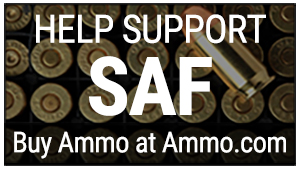
By Mike Nesbitt | Contributing Editor
Hawken rifles have fascinated me for years. Those, mostly percussion, rifles simply have “the look” of guns that can be depended on.
They were built to be the toughest and most rugged guns available at the time of the mountain men, during the fur trade and through the rendezvous era. We might say those Hawken rifles were just as tough as the mountain men who used them.
But there was another side to the owners and shooters of the rifles made in the Hawken shop. The Hawken brothers also made rifles for local Missouri customers, guns that might be called sporting rifles rather than plains rifles, smaller and lighter than the “mountain rifles.” Those lighter rifles made by Hawken have not found the same degree of fame as the heavier plains rifles but they are certainly worthy of just as much praise.

Several years ago, a picture in the book The Plains Rifle, by Charles Hanson Jr., really caught my eye. (It is on page 28 in the book if you want to take a look.) That picture is a photograph of three rifles and the top rifle is mentioned in the caption as a “Light Hawken Rifle. Probably made for local Missouri trade.” Below that is a typical iron mounted S. Hawken “Mountain Rifle” and the bottom gun is a Spencer/Hawken which was most likely actually made by J.P. Gemmer who bought the Hawken shop in the early 1860s. No other notes are given about the lightweight Hawken.
But that picture was enough. The photograph in the book was good enough to see some of the details and for the size of things, such as the barrel length, good guesses were quickly made. The gun in the picture was guessed at to have a 32-inch barrel and then measured closely with a ruler in order to get a ratio so all the pieces could be measured and scaled-up by using that ratio. I think that system worked pretty well and, if I might say so myself, the rifle turned out very nicely. Building the rifle was done in (the late) Dave Dolliver’s shop and it is one of the better guns that I’ve built.

Some of the pieces had to be modified to fit. For instance, the triggers had to be shortened in order to use the late-style spur trigger guard. That was a quick fix, so to speak, and certainly not hard to do. Most of the Hawken pieces, however, were used just as they came, ready to be fit and finished.
The first piece that was ordered to begin gathering the needed parts was the rifle’s barrel. While the original lightweight Hawken sporting rifle might have been a .40 or a .45, or even smaller, mine was to be made in .50 caliber. The 32-inch barrel was ordered from Rice Barrel Company, a tapered octagon barrel, 15/16-inch wide at the breech and 7/8-inch wide at the muzzle. Rice barrels in calibers larger than .40 have seven rifling grooves, like many of the old originals, and the flat-bottomed grooves are .012 inches deep. This barrel has a rate of twist equaling one turn in 66 inches although other rates of twist can be ordered. To place an order, contact Rice Barrel Company, 555 Ijames Church Road, Mocksville, NC 27028, telephone 336-492-2614. You can also visit their website at www.ricebarrels.com.
Next, a lock was ordered from R.E. Davis & Company, now part of Log Cabin Shop. Their Hawken percussion lock was selected over other Hawken style locks mainly for the shape of their lock’s hammer. The original in the photo sports a rather wide or heavy hammer and the hammer on the Davis lock follows that shape better than the other locks that were looked at. Davis, of course, is another highly regarded and established maker of muzzleloading parts and accessories, easily recommended as a source for getting authentically designed and properly operating parts. A visit to their website is well worth the trip, www.redavis.com, and they have moved since I purchased my gun’s parts from them and their new address is: Log Cabin Shop, 8010 Lafayette Road, P.O. Box 275, Lodi, Ohio 44254. Their phone number is 330-948-1082. They are most certainly in business to get in touch by any of those ways.

For the triggers my order was sent to the L&R Lock Company. The lightweight Hawken rifle could be built with either the long tang or the short bar double set triggers and I really don’t know what the original was equipped with because the photo in The Plains Rifle simply didn’t show that detail. By “long bar or short bar” I mean the length of the trigger plate that the set trigger mechanism is attached to. The heavier Hawken “mountain rifles” usually used the long bar version, with screws coming down from the long tang on the top of the stock’s wrist threaded into the trigger plate. The long trigger plate was selected for this rifle. Also, the L&R triggers were picked because of their straight forward trigger, being the best match for the triggers of the original in the small photograph. L&R is a great place for getting locks as well as triggers and several of my guns use them. To contact this company, and they haven’t moved since I got these parts, write to L&R Lock Company, 2328 Cains Mill Road, Sumter, SC 29154, telephone 803-481-5790. They also have an interesting website at www.lr-rlp.com.
Other steel parts were ordered from Track of the Wolf and they also have not moved or relocated since I bought these parts. Those parts included the cast butt plate, trigger guard, nose cap, and the breech plug. Other small parts were also gotten from Track; such as the rear sight, steel under-rib, lock bolt escutcheon, and the ramrod pipes. Track is also a good source for all of the screws and pins used in the assembly of the rifle. In fact, all of the other parts already mentioned could be ordered from Track because they are one of the biggest supply houses of muzzleloading parts. If you want to see the goods that Track of the Wolf has to offer, take a good trip through their web site at www.trackofthewolf.com. Their address is Track of the Wolf, 18308 Joplin Street NW, Elk River, Minnesota 55330 and their telephone number is 763-633-2500.

One more source for good parts must be mentioned and they are my old friends at Cash Manufacturing Company, although the only part on this rifle that was purchased from them was the wide German silver bladed front sight on the copper base. They are still located at Cash Manufacturing Company, P.O. Box 130, Waunakee, Wisconsin 53597, and their telephone number is 608-849-5664, and their website is at www.tdcmfg.com.
All of those pieces and parts were wrapped up in or around a stock that was cut from a very plain maple blank. The stock was cut to the drop at the comb and at the heel that I wanted and it was made to have a length of pull of just less than 13½ inches. To maintain that length of pull, one of the first metal pieces to be installed was the butt plate and the stock shaping proceeded from there. A cast steel nose cap was used and the forearm of the stock was filed to shape behind it, with the ramrod’s entry pipe installed with two steel pins. Of course, the barrel was installed at the same time and a lot of the stock shaping was done with the barrel in place. Having the barrel in place protects the stock by giving it support while the stock shaping work is being done.

After the final sanding, the stock was stained to the shade of dark walnut that I do favor and then the wood was finished with at least five coats of Tru-Oil from Birchwood Casey. We might say that when the stock was finished and the rifle was then reassembled, it looked like a brand-new gun.
While I will never actually consider myself as a real gunsmith or a rifle-maker, this was one of perhaps only three rifles that I’ve made “from scratch” instead of from a prepared kit. That makes it a rather unique rifle, perhaps as unique as the original shown in The Plains Rifle, and it makes me proud to show the “M. Nesbitt” on the barrel. It turned out to be just what I wanted, a lighter weight percussion rifle that could be used “on the trail” either as a hunting rifle or a target gun at rendezvous and for other doin’s. This gun does please me and now I just might use it with some regularity.
The load I like using in the lightweight .50 has just 45 grains of 3Fg GOEX powder under the patched .490” ball. That’s a light load which works rather well out to and even beyond 50 yards. For a hunting load, perhaps for deer, I’d certainly increase the powder charge.

Most recently I’ve used this rifle in two shooting matches. At the Paul Bunyan club we enjoyed a special Easter match, featuring rabbits for targets, both paper and steel, plus some challenging novelty targets such as little marshmallow “peeps” hanging on strings. I took 4th in that match, out of the 15 shooters, which pleased me quite well. And just a week later, this rifle was used again in the season wrap-up for the Puget Sound Free Trappers. Our standings in this match were never revealed but I did take 2nd, behind Bob DeLisle, in the season’s aggregate, winning a pound of Swiss 2Fg powder. This lightweight Hawken is a shooter.
Our muzzleloading rifles don’t have to be big and heavy to perform well. Some of the heavy rifles need to be big and husky because they fire very heavy bullets with equally heavy powder charges but those we’ll save for more serious shooting and not just the fun. I might be using this lightweight Hawken more often.


